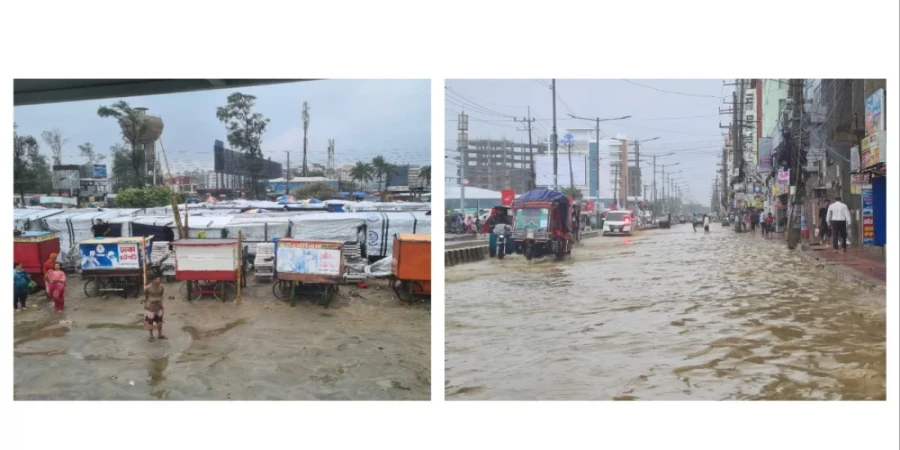
ছবি: Photo: Collected
Triggered by a land depression, rough seas and heavy rainfall have submerged over 50 villages across Cox’s Bazar while isolating Saint Martin’s Island and damaging critical infrastructure along the coast.
Coastal regions of Cox’s Bazar have come under severe threat as rough seas, intensified by a land depression, continue to batter the shoreline. The low-pressure system has resulted in the formation of dense cloud bands over the Bay of Bengal, generating strong gusty winds and heavy rainfall across the region. This adverse weather has led to tidal surges and flooding in at least 50 villages, displacing thousands of people and severely affecting livelihoods.
The coastal aggression has also rendered Saint Martin’s Island completely waterlogged, with its residents now effectively cut off from the mainland due to the suspension of all marine transport. The Bangladesh Meteorological Department’s Cox’s Bazar office reported that the area received 152 millimeters of rainfall in just 24 hours up to noon on Friday. According to Assistant Meteorologist Md. Abdul Hannan, the weather conditions remain volatile, with local warning signal number 3 still in effect for Cox’s Bazar, indicating continued risks of heavy to very heavy rainfall.
By late Friday morning, the impact of the tidal surges was clearly visible at Sugandha Point in Cox’s Bazar, where high waves were breaching the normal tide line. Despite the dangerous conditions, the weekend drew large crowds of tourists to the beach. Many appeared undeterred by the authorities' warnings, choosing instead to witness the dramatic seascape. Strong waves lashed the coastline, damaging beachside shops and putting government structures at risk. Several vendors reported the destruction of their businesses, and facilities belonging to the tourist police were inundated by seawater. Water from the waves even reached the nearby roads at times.
Life guards and tourist police continued their efforts to disperse the crowds, using loudspeakers to issue warnings. Mohammad Shukkur, in charge of the Sea Safe Lifeguard organization, described the widespread impact across several points of the beach. From Madrasa Point to Shaibal Point, rows of casuarina trees were uprooted by the tidal onslaught. Further damages were recorded at Laboni Point, where both public and private establishments, including tourist police boxes and numerous shops, were struck by tidal waves. Sugandha Point witnessed even more serious destruction, with multiple shops submerged and critical infrastructure severely damaged. Kalatoli Point experienced similar conditions.
Shukkur further stated that the unusually high waves, unlike anything seen previously, drew thousands of tourists to Sugandha Point. Despite continuous warnings and efforts to ensure safety, many visitors refused to heed the advisories, resulting in confrontations and disruptions for the safety personnel trying to maintain order.
The situation in the coastal upazilas of Kutubdia, Maheshkhali, Pekua, and Teknaf, including Saint Martin’s Island, is equally dire. Heavy rains combined with tidal inflow have led to extensive flooding across these areas. The worst-hit among them is Kutubdia, where a damaged embankment near the Bayu Biddut Project adjacent to Jasimuddin High School in Ali Akbar’s Dale Union has given way. Seawater is rushing through a 50-meter breach in the embankment, submerging East Para, Sandwip Para, High School Para, and Shanti Bazar under three feet of water.
In the neighboring Kaiarbil Union, Panel Chairman Shafiul Alam Kutubi reported that floodwaters had entered around 200 homes in Maulovi Para and Mofazzal Ahmed Para, both located adjacent to vulnerable sections of the embankment. Similar breaches have been reported in Miarakata and Batighar Para of North and South Dhurang Unions, according to local Union Parishad Chairman Alauddin Al Azad.
Kutubdia’s Upazila Nirbahi Officer (UNO), Kyathoyai Prue Marma, stated that water is continuously flowing in and out of several low-lying areas through the damaged embankments. He identified 7 to 8 critical points on the island where the embankments remain at extreme risk of collapse and confirmed that the Water Development Board has been instructed to undertake urgent repairs.
Sub-divisional Engineer of the Cox’s Bazar Water Development Board, Jamal Morshed, confirmed that at least 20 damaged embankments across Kutubdia, Maheshkhali, and Pekua are allowing seawater to inundate nearby settlements. He added that rough seas have left Saint Martin’s Island isolated for four days as all marine transport services to and from Teknaf have been suspended. This prolonged suspension has left the island’s residents in severe hardship, facing acute shortages of daily necessities.
Rashid Ahmed, president of the Teknaf-Saint Martin Marine Trawler Owners' Association, explained that due to the extreme weather conditions, all types of vessels have been barred from operating. With the supply routes severed, the island’s markets are quickly running out of perishable and essential goods. Acting Chairman of the Saint Martin Union Parishad, Fayezul Islam, echoed these concerns, noting that supplies of fresh produce have already run out and other staples are expected to be depleted imminently. Whatever remains on the market is being sold at inflated prices, placing additional strain on already vulnerable residents.
The people of the island are now trapped, unable to leave or receive adequate support. Teknaf’s Upazila Nirbahi Officer, Sheikh Ehsan Uddin, confirmed that the weather conditions remain hazardous and that warning signal number 3 is still in effect. As a result, all maritime operations will remain suspended until the situation improves.
In addition to the coastal threats, there are rising concerns over the possibility of landslides in the hilly areas of Teknaf and Ukhiya. These upazilas are home to 33 Rohingya refugee camps, housing approximately 1.3 million displaced individuals. A significant portion of this population resides in makeshift shelters situated on or near unstable hill slopes, increasing the risk of landslides during periods of heavy rain.
As meteorologists continue to monitor the depression and issue alerts, authorities are bracing for more rain, stronger tides, and further disruption in the coming days. Emergency responders remain on high alert, while residents in vulnerable areas are urged to take necessary precautions.
repoter






